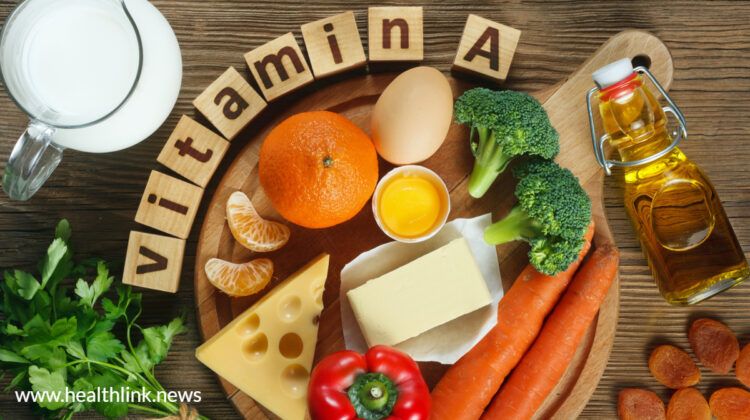What foods have vitamin a - Docindia.org

Many foods are naturally high in vitamin A, which, among other things, plays an essential role in maintaining vision. Through its support of immune functions and reproductive health, adequate consumption of vitamin A should prevent the symptoms of deficiency. In this article, we will highlight some of the best food sources of vitamin A to help you reach your daily recommended value.
Some foods are loaded with vitamin A, which is essential for good vision and healthy skin. In many developing countries, where vitamin deficiency is a problem, it also contributes to blindness. While you might think that all orange-colored fruits and vegetables are high in vitamin A, this is not the case.
Vitamin A is an important nutrient for good vision, cell growth and reproduction, the immune system, and helping the body fight disease. The recommended dietary allowance (RDA) Is 900 mcg for men, 700 mcg for women, and 300–600 mcg for children and adolescents. The RDA provides enough vitamin A for the vast majority of people.
20 Foods High in Vitamin A with Nutrition
To avoid developing a vitamin A deficiency, make sure you include foods high in vitamin A in your daily diet. Here are twenty different foods that you should consider including in your next meal.
Foods Contains Vitamin A Nutrition
1. Beef liver — 713% DV per serving 1 slice: 6,421 mcg (713% DV) 100 grams: 9,442 mcg (1,049% DV)
2. Lamb Liver — 236% DV per serving 1 ounce: 2,122 mcg (236% DV) 100 grams: 7,491 mcg (832% DV)
3. Liver Sausage — 166% DV per serving 1 slice: 1,495 mcg (166% DV) 100 grams: 8,384 mcg (923% DV)
4. Cod Liver Oil — 150% DV per serving 1 teaspoon: 1,350 mcg (150% DV) 100 grams: 30,000 mcg (3,333% DV)
5. King Mackerel — 43% DV per serving Half a fillet: 388 mcg (43% DV) 100 grams: 252 mcg (28% DV)
6. Salmon — 25% DV per serving Half a fillet: 229 mcg (25% DV) 100 grams: 149 mcg (17% DV)
7. Bluefin Tuna — 24% DV per serving 1 ounce: 214 mcg (24% DV) 100 grams: 757 mcg (84% DV)
8. Goose Liver Pâté — 14% DV per serving 1 tablespoon: 130 mcg (14% DV) 100 grams: 1,001 mcg (111% DV)
9. Goat Cheese — 13% DV per serving 1 slice: 115 mcg (13% DV) 100 grams: 407 mcg (45% DV)
10. Butter — 11% DV per serving 1 tablespoon: 97 mcg (11% DV) 100 grams: 684 mcg (76% DV)
11. Limburger Cheese — 11% DV per serving 1 slice: 96 mcg (11% DV) 100 grams: 340 mcg (38% DV)
12. Cheddar — 10% DV per serving 1 slice: 92 mcg (10% DV) 100 grams: 330 mcg (37% DV)
13. Camembert — 10% DV per serving 1 wedge: 92 mcg (10% DV) 100 grams: 241 mcg (27% DV)
14. Roquefort Cheese — 9% DV per serving 1 ounce: 83 mcg (9% DV) 100 grams: 294 mcg (33% DV)
15. Hard-Boiled Egg — 8% DV per serving 1 large egg: 74 mcg (8% DV) 100 grams: 149 mcg (17% DV)
16. Trout — 8% DV per serving 1 fillet: 71 mcg (8% DV) 100 grams: 100 mcg (11% DV)
17. Blue Cheese — 6% DV per serving 1 ounce: 56 mcg (6% DV) 100 grams: 198 mcg (22% DV)
18. Cream Cheese — 5% DV per serving 1 tablespoon: 45 mcg (5% DV) 100 grams: 308 mcg (34% DV)
19. Caviar — 5% DV per serving 1 tablespoon: 43 mcg (5% DV) 100 grams: 271 mcg (30% DV)
20. Feta Cheese — 4% DV per serving 1 ounce: 35 mcg (4% DV) 100 grams: 125 mcg (14% DV)
Foods with High Vitamin A
In order to ensure you get your daily vitamin A requirement, it is important to consume a variety of foods high in this nutrient. Each of these eight foods is rich in vitamin A:
Carrots: Rich in beta-carotene, carrots are an important source of vitamin A. A half-cup of carrots contains more than 450 mcg of vitamin A. Beta-carotene is a type of provitamin A that can be converted into vitamin A in the body. Just think: One small snack could cover your daily requirement for this important nutrient.
Spinach: If you are looking to get a little more vitamin A in your diet, spinach is a great place to start. One half a cup serving of raw or cooked spinach has nearly 600% of the recommended daily amount of this essential vitamin. Add spinach to soups and smoothies or cook it into pasta dishes to bolster your diet with vitamins and minerals.
Dairy: Dairy products are a natural source of vitamin A, with many different types of food from this group boasting far more, such as fortified dairy milk or cheese. A single serving (1 cup) of either of these contains between 100 and 300 IUs of vitamin A.
Sweet Potato: Sweet potato is an excellent source of vitamin A. It contains more than 150% of the recommended daily allowance. For people on plant-based diets, sweet potato will be an invaluable food source.
Squash: Great sources of vitamin A include butter and egg yolks, carrots, and sweet potatoes. But pumpkins boast more than any other food. A typical slice of pumpkin pie can provide up to 480 mcg of vitamin A, more than half a day’s requirement.
Cantaloupe: Cantaloupe can provide added health benefits to your diet. Eating a half-cup serving of this versatile fruit can help you meet the daily requirement of Vitamin A; a nutrient that can break down when heated. Cantaloupe is always consumed raw, so adding some of this melon to your diet can increase your vitamin A intake.
Peppers: Peppers are loaded with vitamin A. The best source of this vitamin is the red, sweet versions — a half-cup serving contains nearly 120 mcg. Green peppers, on the other hand, only have 18 mcg. So, if you are looking to get more of this vitamin into your diet, opt for the red ones and spend less time trying to pick off their green bits.
Liver: The liver is one of the richest sources of vitamin A outside of supplements. Cooked liver from any animal contains these nutrients, but cow liver is low enough in fat to be considered by some a healthy food. A single three-ounce serving of cooked Contains 6600 mcg of Vitamin A. liver is nearly as good an option for obtaining the vitamin as cod liver oil. However, because the liver is so high in other fatty acids, consuming it too often or not preparing it properly can result in someone getting more fat than necessary in their diet.
What are the Requirements?
Vitamin A is one of the fat-soluble vitamins, which means it cannot be stored in your body. It is also used as an antioxidant to fight heart disease and can help you see in the dark. Plenty of foods contains added vitamin A, including cereals, margarine, and dairy products. However, if you eat a healthy diet, many of the foods that contain added vitamin A also contain other vitamins and minerals that are good for your health.
Although some vitamin A-rich foods, such as carrots and spinach, are high in fiber, and fiber decreases the absorption of fat-soluble vitamins from foods (due to the presence of compounds called Phytate that bind with these molecules), there is a way to improve the absorption of vitamin A from provitamin A carotenoids in plant sources, such as carrots and sweet potatoes.
If you are concerned about vitamin A deficiency, or if you are a vegan, it may seem difficult to meet your vitamin A requirements. Fortunately, foods abundant in vitamin A are usually easy to come by and most are an excellent addition to a healthy diet.
Vitamin A is an important fat-soluble vitamin found in many types of food. Your body needs it for maintaining your reproductive health, your eyesight, and your immune system. Both forms of vitamin ‘A’—retinol and beta-carotene—are available in supplement form. However, research suggests that it is best absorbed by sources of dietary fats.
Why Do You Need Vitamin A?
Like a lot of us, you probably think you are doing a good job getting enough vitamin A from the foods you eat. But did you know that good health is as much about what you are not eating and avoiding as it is about eating a healthy diet? Did you know that having too little or too much vitamin A can make you sick?
Vitamin A is a fat-soluble vitamin that helps maintain the surface of the epithelial cells. It also supports the immune system and protects against a number of viruses, bacteria, and fungi. There are two types of vitamin A: retinol and carotenoids. Retinols can be found in preformed sources, such as animal meat and milk products, while carotenoids are found in plant-derived foods. Carotenoids include beta-carotene, alpha-carotene, and lycopene.
Vitamin A plays an important role in many-body systems, including:
Immune Health: Vitamin A is an essential nutrient your body needs to keep you healthy. In addition to promoting a robust immune system, vitamin A also helps support these cells communicate and regulating themselves effectively.
Reproductive Health: Reproductive health is the main reason you need Vitamin A in your diet. Whether you are male or female, your parents likely told you to eat more carrots when you were young. Just as they told you, carrots have a high concentration of Vitamin A, which helps to prevent birth defects and reduces the risk of infertility.
Eye Health: Vitamin A is an essential nutrient. It helps to maintain the health of your retinas, preventing degenerative conditions like macular degeneration.
